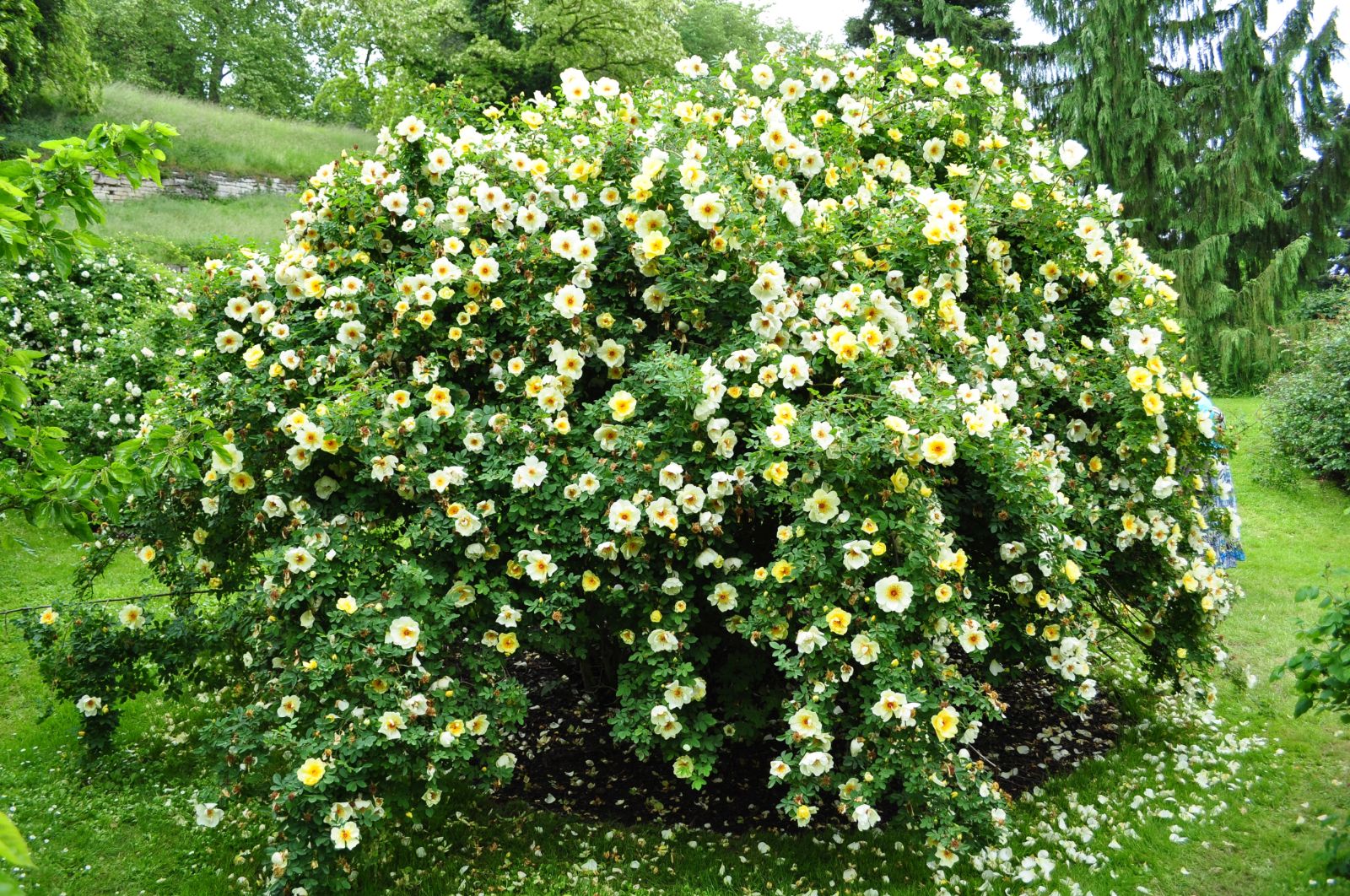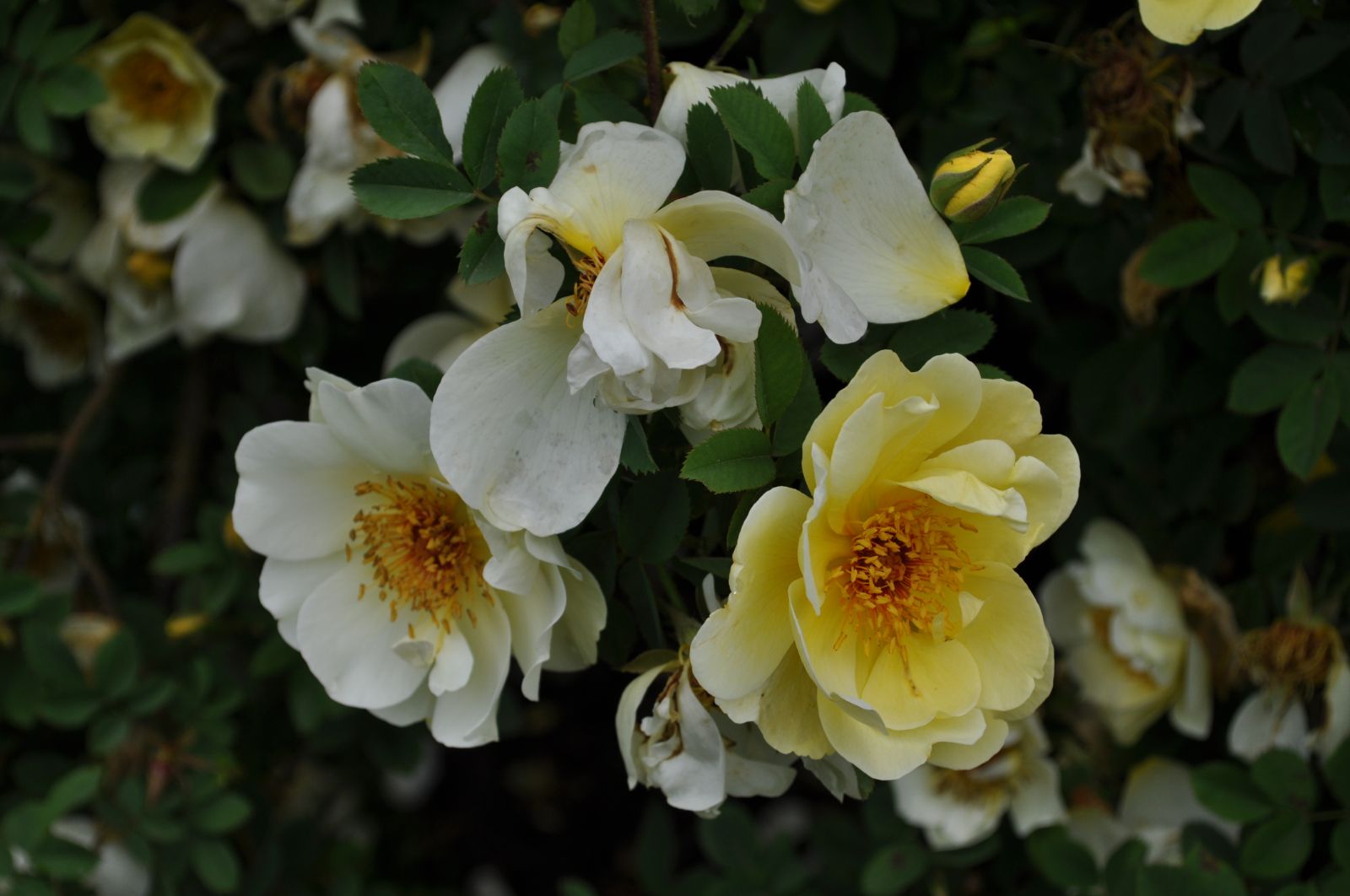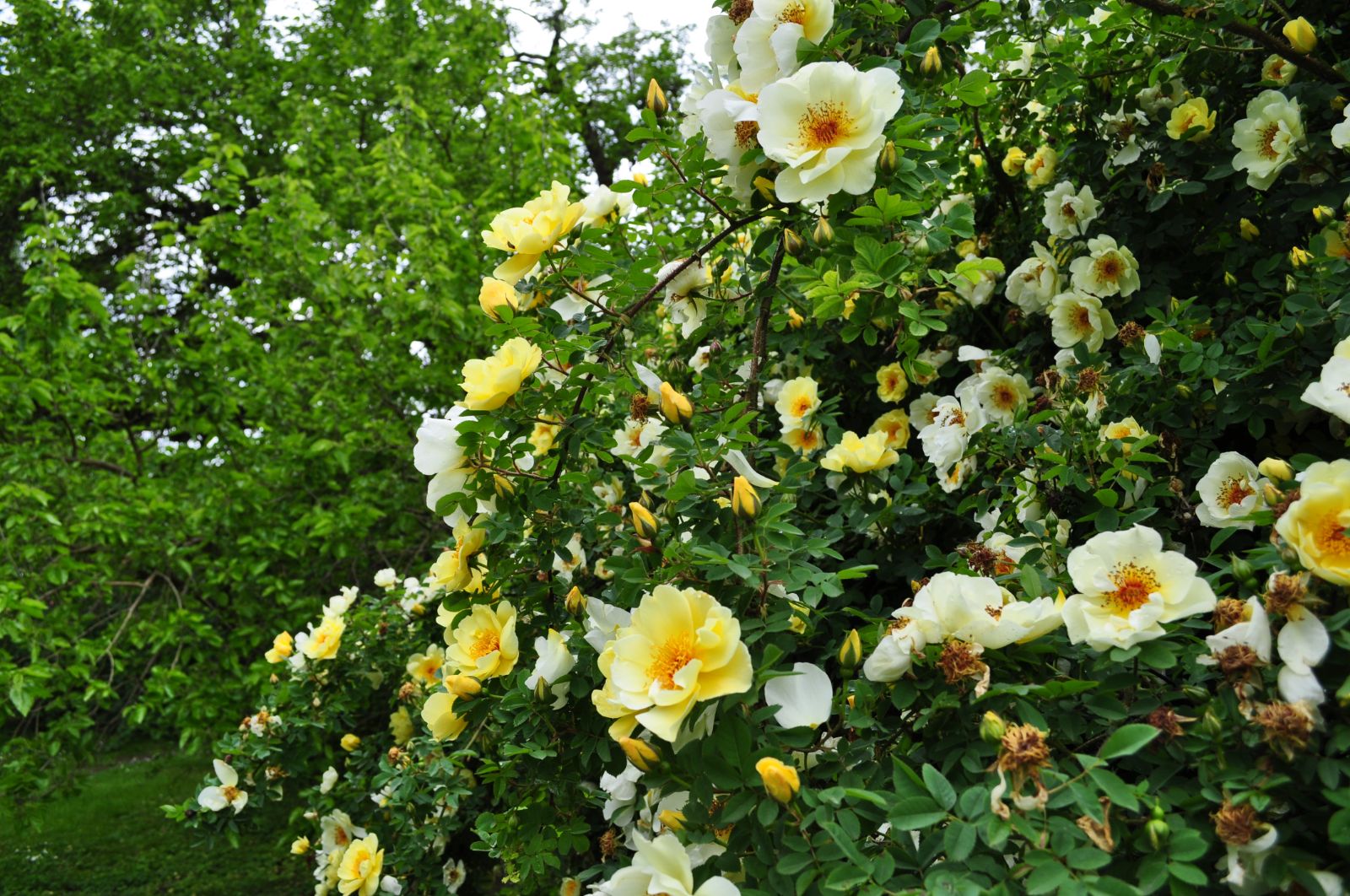Rosa pimpinellifolia
Credits
Article from Bean's Trees and Shrubs Hardy in the British Isles
Recommended citation
'Rosa pimpinellifolia' from the website Trees and Shrubs Online (treesandshrubsonline.
Genus
Common Names
- Burnet Rose
Synonyms
- R. spinosissima L. (1771), not L. (1753)
- R. scotica Mill.
- R. spinosissima var. pimpinellifolia (L.) Hook. f.
Infraspecifics
Other taxa in genus
- Rosa acicularis
- Rosa × alba
- Rosa albertii
- Rosa anemoniflora
- Rosa arkansana
- Rosa arvensis
- Rosa banksiae
- Rosa beggeriana
- Rosa biebersteinii
- Rosa blanda
- Rosa bracteata
- Rosa brunonii
- Rosa californica
- Rosa canina
- Rosa carolina
- Rosa centifolia
- Rosa cerasocarpa
- Rosa chinensis
- Rosa corymbulosa
- Rosa damascena
- Rosa davidii
- Rosa 'Dupontii'
- Rosa ecae
- Rosa eglanteria
- Rosa elegantula
- Rosa elymaitica
- Rosa fedtschenkoana
- Rosa filipes
- Rosa foetida
- Rosa foliolosa
- Rosa × fortuniana
- Rosa × francofurtana
- Rosa gallica
- Rosa gigantea
- Rosa glauca
- Rosa glutinosa
- Rosa gymnocarpa
- Rosa × harisonii
- Rosa helenae
- Rosa hemisphaerica
- Rosa × hibernica
- Rosa hugonis
- Rosa × involuta
- Rosa jundzillii
- Rosa laevigata
- Rosa longicuspis
- Rosa 'Macrantha'
- Rosa macrophylla
- Rosa majalis
- Rosa maximowicziana
- Rosa moyesii
- Rosa mulliganii
- Rosa multibracteata
- Rosa multiflora
- Rosa nitida
- Rosa nutkana
- Rosa palustris
- Rosa pendulina
- Rosa persica
- Rosa pisocarpa
- Rosa × polliniana
- Rosa prattii
- Rosa pulverulenta
- Rosa × reclinata
- Rosa × reversa
- Rosa × richardii
- Rosa roxburghii
- Rosa rubiginosa
- Rosa rubus
- Rosa rugosa
- Rosa sempervirens
- Rosa sericea
- Rosa setigera
- Rosa setipoda
- Rosa sicula
- Rosa soulieana
- Rosa stellata
- Rosa tomentosa
- Rosa villosa
- Rosa virginiana
- Rosa 'Watsoniana'
- Rosa webbiana
- Rosa wichuraiana
- Rosa willmottiae
- Rosa xanthina
A dwarf bush with creeping roots, rarely more than 3 or 4 ft high in the typical state, with erect, short-branched stems covered with slender spines and stout bristles intermixed. Leaves closely set on the branches, 1 to 21⁄2 in. long, composed of five, seven or nine leaflets, which are round or oval or broadly obovate, 1⁄4 to 1⁄2 in. long, simply toothed, deep green, and except for the sometimes downy midrib quite glabrous. Flowers 11⁄2 to 2 in. across, white, creamy white or pale pink, solitary, borne in May. Pedicels and receptacle sometimes smooth, sometimes bristly or even prickly. Sepals usually entire and acute, woolly at the edge, smooth and glabrous on the back. Fruits dark brown, finally blackish, globose, 1⁄2 to 3⁄4 in. wide, crowned with the sepals.
A species widely spread in the Old World from Europe (very rare in Scandinavia) to Asia Minor, the Caucasus, W. Siberia and Central Asia. In Britain it is commonest near the sea, on fixed dunes, shingles and cliffs, often forming large colonies, but also occurs inland on limestone heaths and other dry open places. In gardens the species gives way as a rule to its numerous and variable progeny, some of which are very beautiful in their single or double flowers, either deep rose, white striped with rose, or pale creamy yellow. See further on p. 161. Yellow-flowered cultivars once placed under R. pimpinellifolia almost certainly owe their colouring to R. foetida (see R. × harisonii).
Note. The name R. spinosissima formerly often used for this species appears in the first edition of Linnaeus’ Species Plantarum (1753). The nomenclatural diagnosis is taken from his earlier work Flora Suecica (1745), p. 407, and refers to a rose common on field-margins and in field-hedges in the Swedish province of Uppland and known there as the butter-hip rose in allusion to its pulpous fruits. This rose is R. majalis (cinnamomea), which Linnaeus had seen earlier during his journey to Lapland (Fl. Lapponica (1737), p. 203). In all the works cited, Linnaeus wrongly identifies the rose of Uppland and Lapland with the R. campestris spinosissima flore albo odorata of Caspar Bauhin’s Pinax (1623), p. 483, which is cited as a synonym of R. spinosissima in Species Plantarum, and with the R. pumila spinosissima foliis pimpinellifoliis glabris flore albo of Jean Bauhin’s Historia Plant arum, Vol. II (1651), p. 40. The rose so named by the Bauhins is indeed the Burnet or Scotch rose, R. pimpinellifolia, but this species is exceedingly rare in Scandinavia and had still to be discovered there in 1753.
Thus from the start R. spinosissima was a confused name. But in cases such as this it is the element actually known to and described by the author that must be taken as the type of the species, which in this instance is the rose of Uppland and Lapland – R. majalis (cinnamomea). The objection that Linnaeus described R. majalis in the first edition of the Species Plantarum as R. cinnamomea is invalid, since the rose so named is R. pendulina. It is the R. cinnamomea of the second edition that is the May or Cinnamon rose, which must now be known as R. majalis J. Herrm.
The unambiguous name R. pimpinellifolia was first published by Linnaeus in 1759 and is used in the second edition of Species Plantarum (1762). The R. spinosissima of this edition, as redefined by Linnaeus in 1759, is R. pimpinellifolia, so far as the diagnosis is concerned, though elements of the old confusion remain. This revised R. spinosissima differed from R. pimpinellifolia in having prickly peduncles against smooth in the latter, and some later botanists continued to recognise both species, adding other supposed differences.
In one of his last works, the Mantissa Altera of 1771, Linnaeus gives an excellent description of the Burnet rose under the name R. spinosissima and comes near to making R. pimpinellifolia a synonym of it. It is therefore not without good reason that some botanists have upheld the name R. spinosissima, and Crépin was perhaps a little unjust in writing of them ‘Ils n’avaient pas étudié les faits avec assez d’attention.’ (Bull. Herb. Boiss., 2nd ser., Vol. 5, p. 143). But the fact remains that the R. spinosissima L. of the first edition of Species Plantarum, where botanical nomenclature starts, is R. majalis. Pointing this out in 1820, the Swedish botanist Wikström proposed that the name R. spinosissima should either be applied to that species or rejected ‘in aeternum’ as a source of confusion (Kongl. Vet. Acad. Handl., 1820, p. 268).
Footnotes
The name R. ochroleuca has been variously used in gardens. The rose grown by Canon Ellacombe under this name seems, judging from herbarium specimens, to have been a beautiful rose, with flowers in twos or threes up to almost 4 in. across, but is obviously a hybrid. Plants distributed commercially as R. ochroleuca are mentioned on p. 101 under ‘Lutea Maxima’. R. spinosissima var. ochroleuca (Swartz) Baker, in Willmott, The Genus Rosa, Vol. II, p. 255, is a compound of four discrepant elements: R. ochroleuca Swartz; the R. spinosissima luteola of Andrews (see f. luteola); R. xanthina (to which the specimen from N. China cited by him belongs); and the rose cultivated by Miss Willmott as R. ochroleuca, which is portrayed in the facing plate and is of uncertain identity.
f. luteola (Andr.) Rehd. (in
Synonyms
R. spinosissima) R. spin. luteola Andr.
Roses , Vol. II, t. 128
f. megalacantha Borbas ex Dengler
Prickles long, much flattened, with an elongated base. A variant of this nature was mentioned in previous editions as var. macracantha, an unpublished name written on a specimen in the Kew Herbarium, collected near Gap in the Alpine region of S.E. France, which has flat, rigid spines {5/8} in. long and {1/4} in. wide at the base.Numerous natural hybrids of R. pimpinellifolia are known, of which the following are treated in this work:Rosa pimpinellifolia × R. canina and related species. See R. × hibernica.” ” × R. sherardii and related species. See R. × involuta.” ” × R. glauca. See under the latter species.” ” × R. pendulina. See R. × reversa.” ” × R. foetida. See R. × harisonii.Crossed with Hybrid Teas, R. pimpinellifolia ‘Grandiflora’ has given rise to some of the finest of the shrub roses. See in the second section: ‘Frühlingsanfang’, ‘Frühlingsgold’, ‘Frühlingsmorgen’, ‘Karl Foerster’ and ‘Maigold’.'Grandiflora' ("Altaica")
A suckering shrub up to 6 ft high, differing from R. pimpinellifolia as usually seen in Europe not only in its large size but also in the absence or comparative scarcity of bristles among the prickles of the stems. The flowers are 3 in. across, creamy white, and the leaflets up to 1 in. long. Bot. Reg., t. 888. (R. grandiflora Lindl.; R. spinosissima var. altaica (Willd.) Bean, not R. altaica Willd.; see further under var. altaica).A group of this rose when in full bloom at the end of May makes a very beautiful picture. It was introduced from Siberia before 1820.'Hispida'
A shrub up to 6 ft high, with sturdy, erect stems densely covered with slender, brown bristles. Leaflets five to eleven, {3/4} to 1{1/4} in. long, {3/8} to {1/2} in. wide, glabrous. Flowers yellow at first, changing to creamy white, 2 to 3 in. wide, opening the third or fourth week in May. Bot. Mag., t. 1570. (R. hispida Sims (1813), not Muenchh. (1770); R. lutescens Pursh; R. spinosissima var. hispida (Sims) Koehne).There was some doubt as to the origin of this rose, which was at one time called the ‘Yellow American rose’ and was included by Pursh in his Flora of North America, but there is every reason to believe that it came from Siberia. It has been raised from seed at Kew and comes quite true, which would appear to show that it is not of hybrid origin. It is one of the most lovely of single roses, but uncommon in cultivation.At the end of the 18th century plants were raised in Sweden from seeds received from Russia, and were named R. ochroleuca by Swartz, who further distributed plants and seeds. The first full description, accompanied by an excellent portrait, was published by Wikstrom in Kongl. Vetensk. Acad. Handl. 1820, p. 268 and t. III. Judging from these, R. ochroleuca was very similar to ‘Hispida’, as indeed Wikstrom pointed out.var. altaica (Willd.) Thory
Synonyms
R. altaica Willd.
R. spinosissima var. altaica (Willd.) Bean
R. altaica Willdenow (1809) is a renaming of the R. pimpinellifolia of Pallas in Flora Rossica, Vol. II (1789), p. 62 and t. 75, which is a Siberian form of the species resembling ‘Hispida’ in its bristly but not prickly stems and its yellowish white flowers. Thory rightly placed R. altaica under R. pimpinellifolia as a variety, but Seringe, in de Candolle’s Prodromus, gives a diagnosis of var. altaica that seems to be based mainly on R. grandiflora Lindl., which he cites as a synonym. The R. spinosissima var. altaica of previous editions of the present work, and of Render’s Manual (1940 edition) is wholly R. grandiflora Lindl. except for the citation R. altaica Willd. But Lindley’s plant (see ‘Grandiflora’) is at the opposite pole to R. altaica Willd. so far as armature is concerned. See further under ‘Hispida’.
var. lutea Bean (in
Synonyms
R. spinosissima )
var. lutea plena Hort
See ‘Williams’s Double Yellow’, p. 204.var. myriacantha (DC.) Ser.
Synonyms
R. myriacantha DC



